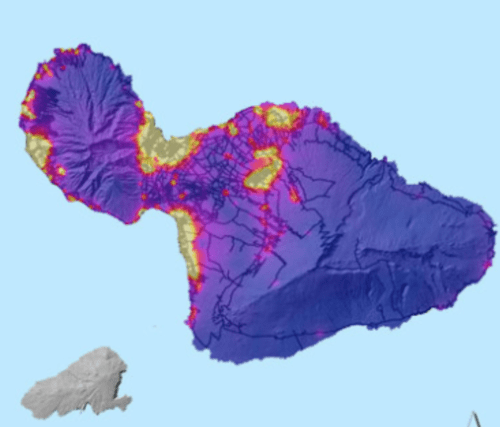In "Partner Perspectives" we get to know the diverse people, roles, and views of wildfire management in the Pacific. This month, we feature Shayna Decker, Manager of Communications for Maui Electric Company to provide her perspective regarding a utility company’s role in preventing and dealing with wildfire in Hawai‘i.
Name: Shayna Decker
Role: Communications Manager, Maui Electric Company
Describe your relationship to wildfire and how it influences organizational behaviors and/or practices, even challenges.
Our island communities depend on electricity day in and day out. This is why Maui Electric takes its responsibility of providing safe and reliable power to its more than 70,000 customers on Maui, Moloka‘i and Lāna‘i very seriously. As part of this commitment, risk mitigation is an important component of Maui Electric’s efforts to build resilient electrical grids on the three islands it serves. In preparing for different risks that can threaten an island’s electrical system, recent wildfires experienced on Maui are cause for everyone to remain vigilant when it comes to establishing resiliency against such unplanned natural forces that burn in forests and other untended wildlands with abundant dry shrubs and grass.
What best practices are being implemented and/or explored by MECO?
Such resiliency work starts with proactive vegetation management around the company’s electrical infrastructure and facilities. In 2019, about $3.2 million was spent to clear and trim brush, trees, and branches around the company’s equipment and facilities in Maui County. The company also works with area landowners to maintain vegetation when the electrical infrastructure is on private property.
In addition to ongoing vegetation management, in 2019, Maui Electric as part of the Hawaiian Electric Companies, evaluated the wildfire mitigation plans filed by the major utilities in California and studied Hawai‘i fire ignition maps to determine where the greatest risks are and to provide a basis for additional mitigation planning.
The preliminary findings noted that unlike California, many utility lines in Hawai‘i run through tropical areas that typically receive


abundant rainfall. That makes it easier to concentrate on mapping electrical infrastructure in more drought-prone areas where dry grass and brush have a greater potential to ignite.
As part of these efforts, the company is using drones - or unmanned aircrafts - to survey its equipment and infrastructure in drier parts of the islands in particular. The drones assist in identifying more remote areas vulnerable to wildfire and determine the best course of action to help protect the public, as well as the company’s electrical infrastructure.
What efforts are you taking to protect critical utility infrastructure?
Other resilience initiatives launched by Maui Electric to prevent wildfires include:
· Installing heavier, insulated conductors to stop lines from slapping together in areas prone to high winds. The company is identifying more areas where it makes sense to install these conductors when undergrounding equipment is not possible.
· Installing smart switches and smart fuses to minimize sparks from being created when lines come into contact with each other and vegetation.
· Applying fire retardants on poles identified in identified fire hazard areas. The Hawaiian Electric Companies also tested several different fire retardants on wooden poles in a controlled burn to determine which products will best protect the companies’ infrastructure.
With climate change producing drier and hotter weather patterns and longer fire seasons, Maui Electric will continue to prioritize resiliency to uphold its commitment to powering our communities safely and reliably.
To learn more about Maui Electric’s efforts on emergency preparation and its move to renewable energy to reduce our state’s overall carbon footprint that contributes to climate change, check out www.mauielectric.com.
With climate change producing drier and hotter weather patterns and longer fire seasons, Maui Electric will continue to prioritize resiliency to uphold its commitment to powering our communities safely and reliably.
To learn more about Maui Electric’s efforts on emergency preparation and its move to renewable energy to reduce our state’s overall carbon footprint that contributes to climate change, check out www.mauielectric.com.
